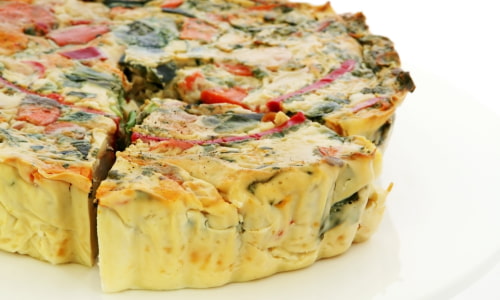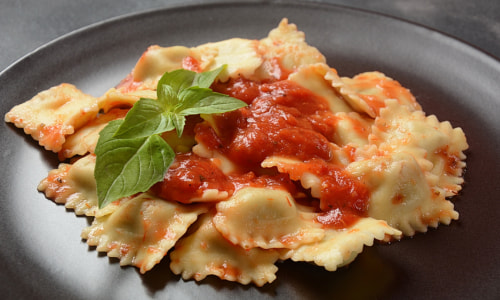21 Meals for Elderly with No Teeth
“21 Meals for Elderly with No Teeth” was written by Amber Lam, RD & edited/reviewed by Aly Bouzek, MS, RDN.
As we age, we are more likely to encounter dental problems. So much so, that 68% of adults aged 65 years or older have periodontitis in the United States. Periodontitis is also known as gum disease and can lead to mouth pain and tooth loss.
Dentures are a common substitute when teeth are lost; however, dentures can be costly, don’t work as efficiently as natural teeth, and some find wearing them to be uncomfortable.
Because of this, there is a strong link between dental health and nutrition. We need to be making appropriate meals for elderly with no teeth an important part of maintaining overall health.
Nutrition Needs for Meals for Elderly with No Teeth
Many foods contain specific nutrient benefits. For example, we often associate milk with calcium and vitamin D, meat with protein, and orange juice with vitamin C.
However, the foods that are more difficult to eat without teeth, are often those with high nutrient value, such as meats and raw vegetables.
To ensure that meals for elderly with no teeth contain adequate nutrients, including protein and fiber, we need to make sure that food substitutions or alterations contain similar nutrient values.
Specific Nutrients of Importance
Seniors may need certain nutrients, or more of specific nutrients to keep up with their health while aging.
Some of these specific nutrients and their recommended amounts from the Dietary Guidelines for Americans 2020-2025 include:
| Nutrient | Recommended Amounts for Females (aged 51+ yrs) | Recommended Amounts for Males (aged 51+ yrs) |
| Vitamin A | 700 mcg | 900 mcg |
| Vitamin C | 75 mg | 90 mg |
| Vitamin D | 600 IU | 600 IU |
| Vitamin B12 | 2.4 mcg | 2.4 mcg |
| Calcium | 1200 mg | 1000 mg |
| Iron | 8 mg | 8 mg |
Let’s learn more about these nutrients and what foods we can find them in!
Vitamin A
Vitamin A is an important nutrient for vision health. We also need vitamin A to help protect our immune system. Adding vitamin A to your diet is as simple as adding:
- Well-cooked carrots
- Well-cooked broccoli
- Well-cooked squash
- Cheese
- Eggs
- Fortified cereals
Vitamin C
Vitamin C is another nutrient that helps protect your immune system. It also supports wound healing, tissue repair, and is necessary for iron absorption.
This antioxidant is in foods such as:
- Citrus fruits (oranges, pineapple, etc.)
- Leafy greens
- Potatoes
- Tomatoes
- Berries
Vitamin D
Vitamin D is important for elderly because, as we age, we lose bone density. This means that our bones become weak, frail, and easier to break if we fall or are injured. Vitamin D also helps support and maintain a healthy immune system.
Add some vitamin D to your soft foods diet with:
- Cooked and tender salmon
- Fortified foods such as: milk, cereals, yogurt, orange juice
Vitamin D helps support bone health by absorbing the calcium we get from our food. Be sure you are getting enough of these two nutrients to support your bones!
Click to learn more about vitamin D.
Vitamin B12
Vitamin B12 is such an important nutrient – it’s involved in every cell in our body! It helps in the creation of red blood cells, DNA, and assists with nervous system function.
Foods high in vitamin B12 to add to meals for elderly with no teeth include:
- Cooked and tender poultry
- Cooked and tender fish
- Yogurt
- Milk
- Eggs
- Fortified nutritional yeast
- Fortified cereals
Learn more about vitamin B12 here.
Calcium
Calcium is well known for it’s help in maintaining strong and healthy teeth and bones. With this benefit comes a lower risk of bone fractures and bone disorders such as osteoporosis.
Did you know that calcium is also the most abundant mineral in the body? It healps with almost every function, from moving muscles to boosting brain function.
Add more calcium to your diet with these foods:
- Milk and other dairy products
- Soybeans
- Cooked and tender salmon
- Dark leafy veggies
- Calcium-fortified foods
Remember to eat enough vitamin D-rich foods to support calcium absorption! If your vitamin D levels are too low, then the amount of calcium absorbed is also lower.
Click to learn more about calcium and why it’s important for our overall health.
Iron
Iron is responsible for moving oxygen from the lungs to every part of your body (hemoglobin). It’s also responsible for carrying oxygen to your muscles (myoglobin). Having enough iron in your diet also helps to prevent iron deficiency anemia.
Foods high in iron to add to meals for elderly with no teeth include:
- Well-cooked, tender, and moist red meats
- Well-cooked poultry
- Well-cooked white beans
- Tuna
- Eggs
- Fortified cereal
- Oatmeal
To help your body absorb the iron in these foods, make sure to include foods high in vitamin C (like citrus fruits, tomatoes, etc.) in the same mealtime.
Protein & Fiber
In addition to the above specific vitamins and minerals, protein is also important for healing wounds and making sure your body runs efficiently.
Additionally, fiber is important for the maintaining a healthy digestive system. It helps add bulk to your stool and move your stool through your digestive system. Avoid constipation by adding some fiber (and water!) to your diet.
We want to make sure that these nutrients are a part of meals and snacks for elderly with no teeth. To do this, we need to learn more about what meals are safe and appetizing for elderly with no teeth.
What Kinds of Meals are Suitable for Elderly with No Teeth?
Without being able to rely on teeth to chew, these meals need to be soft to make mealtimes safe.
Depending on other limitations that may be present, appropriate meals can be prepared using regular foods that are easy to mush around in the mouth prior to swallowing.
Foods to Include
Meals for elderly with no teeth don’t have to be pre-prepared. Some foods are naturally soft/tender in texture like applesauce, smooth yogurt, and strained soup.
Other foods, like raw vegetables or uncooked beans, will need to be well-cooked and moist to ensure safe eating.
Note: easy to chew foods are not appropriate for someone with a choking risk or who has trouble swallowing. If supervision is needing during mealtimes to prevent these serious situations, then this is not a safe diet for you.
Foods to Avoid
Before we dive into appropriate foods to include in meals for elderly with no teeth, let’s review foods that may be harder to chew and not as easy to consume for elderly with no teeth.
These foods can be a choking hazard, can cause mouth pain, and can make mealtimes less enjoyable. Take a look at the table below.
| Food Characteristics to Avoid | Examples of Foods to Avoid |
| Hard or dry food | Nuts, raw vegetables (e.g. carrot, cauliflower, broccoli), dry cakes, bread, dry cereal |
| Tough or Fibrous Foods | Steak, pineapple |
| Chewy | Lollies/candies/sweets, cheese chunks, marshmallows, chewing gum, sticky mashed potato, dried fruits, sticky foods |
| Crispy | Crackling, crisp bacon, cornflakes |
| Crunchy food | Raw carrot, raw apple, popcorn |
| Sharp or spiky | Corn chips/crisps |
| Pips, seeds | Apple seeds, pumpkin seeds, white of orange |
| Bone or gristle | Chicken bones, fish bones, other bones, meat with gristle |
| Sticky or gummy foods | Edible gelatin, konjac containing jelly, sticky rice cakes |
| Stringy foods | Beans, rhubarb |
Sourced from: The International Dysphagia Diet Standardisation Initiative 2019 @ https://iddsi.org/framework/. Licensed under the CreativeCommons Attribution Sharealike 4.0 License https://creativecommons.org/licenses/by-sa/4.0/legalcode. Derivative works extending beyond language translation are NOT PERMITTED.
Turning Regular Foods Into Easy to Chew Foods
Now that we are aware of what foods to avoid, we can take a look at how to prepare appropriate nutritious, appealing, and varied meals for elderly with no teeth.
Fruits and Vegetables
Vegetables can be made softer by steaming or boiling. Fruits should be soft enough to break into pieces with a spoon. Fibrous parts of fruit should be removed, such as apple skins and the white fibers in an orange.
Fruits that can not be found in soft form can be blended into a delicious smoothie for breakfast. Different colored fruits and vegetables are rich in different nutrients, so the more colorful your plate is, the more varied the nutrients!
Meat, Fish, and Protein
Meats can be cooked until tender, or slow-cooked with sauce added. Ground meats such as ground turkey, beef, and pork are often easier to chew. Fish when steamed or baked are generally soft enough and require minimal chewing.
Grains and Dairy
A lot of grain and dairy foods do not need any changes to be appropriate in meals for elderly with no teeth. Many grains such as rice, oatmeal, pasta, and lightly toasted bread are all soft in their natural form.
Note that these foods may be soft, but many of them may be too dry to enjoy. Try adding liquids/moist condiments to the foods (add broth to rice, milk to oatmeal, butter to bread) to make them more moist.
Most dairy products such as yogurt, milk or milk alternatives, and soft cheese are all easy to drink or eat for elderly with no teeth. This being said, it is important to check with your clinician to ensure that hat you are preparing is appropriate.
21 Meals for Elderly with No Teeth
Take a look at our list of 21 meals appropriate for elderly with no teeth. We’ve included 3-4 food groups and took into account the varied nutrition needs to consider when preparing the meals.
By choosing a variety of foods that are appropriate, meals for elderly with no teeth can be tasty, appetizing, and nutritious.
Breakfast Meals for Elderly with No Teeth
- Scrambled eggs with lightly toasted multi-grain bread, milk, and canned fruit cup
- Oatmeal or cream of wheat topped with blueberries and milk
- Breakfast smoothie made with frozen berries, spinach, milk or milk alternative, ground flax seeds, and Greek yogurt
- Eggs Benedict served with orange juice
- Lightly toasted multigrain bread topped with creamy nut butter and a banana
- French toast topped with berries and whipped cream, serve with milk
- Omelet with cheese and soft/cooked vegetables
Lunch Meals for Elderly with no Teeth

- Beef (very tender) stew with potatoes and vegetables
- Grilled cheese on multigrain bread, served with a side of soft-fruit
- Tomato soup and lightly toasted sandwich that includes meat or a nut butter
- Tuna pasta salad with cooked peas or other soft vegetables
- Macaroni and cheese served with 100% juice
- Quiche with cheese, spinach, and feta
- Lentil and vegetable soup
Dinner Meals for Elderly with No Teeth

- Cheese ravioli and tomato sauce
- Shepard’s pie
- Salmon, rice, and steamed broccoli with butter
- Slow-cooked roast beef shredded with gravy, garlic mashed potatoes, and steamed green beans
- Pulled pork on a bun, served with cut-up steamed carrots
- Cheesy mashed potatoes served with very tender Salisbury steak and creamed corn
- Fish cakes, served with dipping sauce and a side of soft vegetables
Conclusion
Meals for elderly with no teeth can be tasty, easy to chew, and still meet nutrient needs. With variety and a few extra steps to steam longer, add a sauce, or make a substitution, meals can continue to be an enjoyable, appetizing experience.

So amazing how you put it all together so effortlessly (it seems 🙂 Thanks for ideas and help.